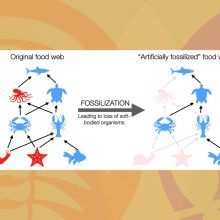
Marine diagenesis of tephra aided the Palaeocene-Eocene Thermal Maximum termination
Sign Up to like & getrecommendations! Published in 2021 at "Earth and Planetary Science Letters"
DOI: 10.1016/j.epsl.2021.117101
Abstract: Abstract The Palaeocene-Eocene Thermal Maximum (PETM) was a period of intense global warming that began ∼55.9 million years ago and lasted about 170,000 yrs. Various mechanisms have been proposed to cause this warming, including the… read more here.
Keywords: palaeocene eocene; thermal maximum; eocene thermal; tephra ... See more keywords

Shallow marine ecosystem collapse and recovery during the Paleocene-Eocene Thermal Maximum
Sign Up to like & getrecommendations! Published in 2021 at "Global and Planetary Change"
DOI: 10.1016/j.gloplacha.2021.103649
Abstract: The Paleocene-Eocene Thermal Maximum (PETM), the most well-studied transient 25 hyperthermal event in Earth history, is characterized by prominent and dynamic 26 changes in global marine ecosystems. Understanding such biotic responses provides 27 valuable insights… read more here.
Keywords: thermal maximum; paleocene eocene; eocene thermal; shallow marine ... See more keywords

Benthic foraminiferal biotic events related to the Paleocene–Eocene Thermal Maximum along the California margin
Sign Up to like & getrecommendations! Published in 2019 at "Marine Micropaleontology"
DOI: 10.1016/j.marmicro.2019.04.004
Abstract: Abstract The faunal expression of the Paleocene-Eocene Thermal Maximum (PETM) is well documented in deep-sea sediments. However, few studies have examined continental margin sections, especially active margins. The Moreno and Lodo formations, Central California, were… read more here.
Keywords: margin; petm; benthic foraminiferal; paleocene eocene ... See more keywords

Identifying disruptions to the ecological balance of nature: a foraminiferal example across the initiation of the Paleocene–Eocene thermal maximum
Sign Up to like & getrecommendations! Published in 2019 at "Paleobiology"
DOI: 10.1017/pab.2018.45
Abstract: Abstract. Deriving ecological and evolutionary descriptions of, and implications from, faunal assemblage patterns is commonly addressed by observation and a variety of exploratory techniques (scaling and clustering), along with qualitative evaluations of species occurrences and… read more here.
Keywords: paleocene eocene; community; example; eocene thermal ... See more keywords

Evaluating the responses of three closely related small mammal lineages to climate change across the Paleocene–Eocene thermal maximum
Sign Up to like & getrecommendations! Published in 2021 at "Paleobiology"
DOI: 10.1017/pab.2021.12
Abstract: Abstract. Interpreting the impact of climate change on vertebrates in the fossil record can be complicated by the effects of potential biotic drivers on morphological patterns observed in taxa. One promising area where this impact… read more here.
Keywords: paleocene eocene; change; eocene thermal; biotic drivers ... See more keywords

Carbonate Dissolution Enhanced by Ocean Stagnation and Respiration at the Onset of the Paleocene‐Eocene Thermal Maximum
Sign Up to like & getrecommendations! Published in 2019 at "Geophysical Research Letters"
DOI: 10.1029/2018gl080761
Abstract: The Paleocene‐Eocene Thermal Maximum was a transient, carbon‐induced global warming event, considered the closest analog to ongoing climate change. Impacts of a decrease in deepwater formation during the onset of the Paleocene‐Eocene Thermal Maximum suggested… read more here.
Keywords: thermal maximum; carbonate dissolution; eocene thermal; paleocene eocene ... See more keywords

Strong Coupling Between Carbon Cycle, Climate, and Weathering During the Paleocene‐Eocene Thermal Maximum
Sign Up to like & getrecommendations! Published in 2023 at "Geophysical Research Letters"
DOI: 10.1029/2023gl102897
Abstract: The Paleocene‐Eocene Thermal Maximum (PETM; ∼56 Ma)–a geologically rapid carbon‐release event similar to anthropogenic carbon emissions–is ideal for investigating weathering responses to rapid carbon release and associated climate change. Here, for the first time, we… read more here.
Keywords: paleocene eocene; carbon; climate; strong coupling ... See more keywords

Coupled microbial bloom and oxygenation decline recorded by magnetofossils during the Palaeocene–Eocene Thermal Maximum
Sign Up to like & getrecommendations! Published in 2018 at "Nature Communications"
DOI: 10.1038/s41467-018-06472-y
Abstract: Understanding marine environmental change and associated biological turnover across the Palaeocene–Eocene Thermal Maximum (PETM; ~56 Ma)—the most pronounced Cenozoic short-term global warming event—is important because of the potential role of the ocean in atmospheric CO2 drawdown,… read more here.
Keywords: oxygenation; bloom; eocene thermal; palaeocene eocene ... See more keywords

Isotopic filtering reveals high sensitivity of planktic calcifiers to Paleocene–Eocene thermal maximum warming and acidification
Sign Up to like & getrecommendations! Published in 2022 at "Proceedings of the National Academy of Sciences of the United States of America"
DOI: 10.1073/pnas.2115561119
Abstract: Significance Human-induced carbon emissions are causing global temperatures to rise and oceans to acidify. To understand how these rapid perturbations affect marine calcifying communities, we investigate a similar event in Earth’s geologic past, the Paleocene–Eocene… read more here.
Keywords: isotopic filtering; filtering reveals; reveals high; eocene thermal ... See more keywords

Spatial patterns of climate change across the Paleocene–Eocene Thermal Maximum
Sign Up to like & getrecommendations! Published in 2022 at "Proceedings of the National Academy of Sciences of the United States of America"
DOI: 10.1073/pnas.2205326119
Abstract: Significance The Paleocene–Eocene Thermal Maximum (PETM) is a global warming event that occurred 56 Ma in response to an increase in carbon dioxide. Geological data from the PETM are only available from a few places,… read more here.
Keywords: climate change; paleocene eocene; eocene thermal; thermal maximum ... See more keywords

Rapid expansion of meso-megathermal rain forests into the southern high latitudes at the onset of the Paleocene-Eocene Thermal Maximum
Sign Up to like & getrecommendations! Published in 2020 at "Geology"
DOI: 10.1130/g47343.1
Abstract: Current knowledge of terrestrial ecosystem response to the Paleocene-Eocene Thermal Maximum (PETM; ca. 56 Ma) is largely based on the midlatitudes of the Northern Hemisphere. To more fully reconstruct global terrestrial ecosystem response to the… read more here.
Keywords: meso megathermal; megathermal rain; paleocene eocene; eocene thermal ... See more keywords